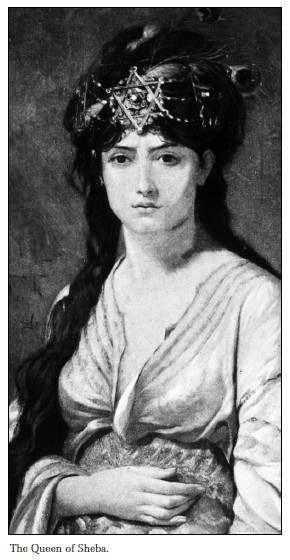THE MYSTICAL FIGURE known as the Queen of Sheba is recorded in the First Book of Kings in the Old Testament. It states that around the tenth century BC a queen of the rich trading nation known as Sheba decided to meet the great King Solomon in person. She did not believe the stories she had been told of Solomon’s wisdom, and brought many hard questions to test him. When his replies met with her approval she gave him plentiful gifts of gold, spices and precious stones. In return, Solomon gave the queen ‘all her desire’, and after their meeting she returned to her own country. The story is repeated in the second Book of Chronicles, and even Christ himself spoke of a queen of the south who came to hear the wisdom of Solomon. Other than this, precious few pieces of historical evidence have survived, but that has not stopped the growth of countless myths and stories. So who was the real Queen of Sheba?
Perhaps the most famous and important extension of her story is that connected with Ethiopia. In 1320 an Ethiopian monk named Yetshak wrote a compendium of legends called Kebra Negast or ‘Glory of the Kings’.
In it, he said that when the Queen of Sheba, referred to in Ethiopian as Makeda, visited Solomon, she was seduced by the great king. Solomon had said that the queen was welcome to his hospitality, but must not take anything without asking. During the night, the Queen suffered a terrible thirst caused by a spicy meal Solomon fed her and she drank the water placed by her bed. The king said she had broken the rules, and must sleep with him as repayment. Nine months later she gave birth to a boy called Menelik.
Ethiopians believe that the Queen and her son both accepted the Jewish faith, and that Menelik founded the Solomon Jewish, and then Christian, dynasty in Aksum, Ethiopia.
At around the same time as Yetshak was compiling his tome, other legends were forming in Europe. A thirteenth century story told in the Legenda Aurea stated that the queen was a prophetess connected to the crucifixion of Christ. Over time, she also became an integral part of religious decorations and art. She was often seen as a sorceress, and then a seductress. Strangely, she is also featured as having a secret deformity – French Gothic sculpture often shows her having a webbed foot. In the same way, the Temptation of Saint Anthony by French novelist Gustave Flaubert depicts the queen as a lustful temptress with a withered limb.
This imperfection perhaps arises from earlier Jewish and Islamic references to her. In both the Koran and the Jewish Book called the Targum Sheni, the queen meets Solomon and reveals that she has hairy feet. The Jewish tradition later features her as a demon or seductress, whereas Islamic legend states that Solomon used his magicians’ power to remove her excess hair and married her. Muslims call the Queen of Sheba Balkis, and believe her great nation was based in the Yemen. The Koran describes Sheba as being two gardens, irrigated by a great dam. An advanced level of farming, and good access to Red Sea shipping channels and Arabian camel trains, meant the nation prospered.
Archaeological proof of this occurring in Southern Arabia has been uncovered. The remains of a great dam can be viewed in the Mareb region of the Yemen, now considered to be the capital of the ancient Sheba nation. This dam collapsed in AD 543, but scientists have been able to deduce that it would have been used to irrigate over 500 acres of farm land. In recent years, archaeologists have finished restoring an ancient temple known as the ‘Throne of Balkis’ in the Mareb region. The structure dates from the tenth century BC, so is from the right era to link with what we do know about the queen. Two miles to the east of the Marab region, another ancient building, known as the ‘Temple of the Moon God’, is also being studied. Scientists using radar equipment believe this is an extremely large and elaborate structure, and could yield the answers to many Sheba mysteries. Unfortunately such investigations have been plagued over the years by political indifference and, until these areas become more secure for researchers to study, the true history of Sheba may continue to be obscured by myth and legend.



tnx po sa blog
ReplyDeletedahil tagal ko na hinahamap
ang tungkol sa reyna ng silangan
o queen of sheba